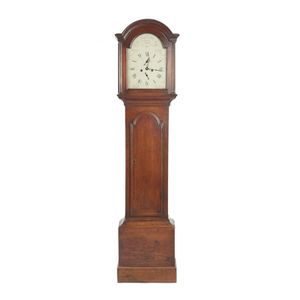English Oak Longcase Clock with Painted Dial and Calendar
You must be a subscriber, and be logged in to view price and dealer details.
Subscribe Now to view actual auction price for this item
When you subscribe, you have the option of setting the currency in which to display prices to $Au, $US, $NZ or Stg.
- Movement - The technical name for the workings of a clock or watch, and does not include the dial or case.
- Oak - Native to Europe and England, oak has been used for joinery, furniture and building since the beginning of the medieval civilisation. It is a pale yellow in colour when freshly cut and darkens with age to a mid brown colour.
Oak as a furniture timber was superceded by walnut in the 17th century, and in the 18th century by mahogany,
Semi-fossilised bog oak is black in colour, and is found in peat bogs where the trees have fallen and been preserved from decay by the bog. It is used for jewellery and small carved trinkets.
Pollard oak is taken from an oak that has been regularly pollarded, that is the upper branches have been removed at the top of the trunk, result that new branches would appear, and over time the top would become ball-like. . When harvested and sawn, the timber displays a continuous surface of knotty circles. The timber was scarce and expensive and was used in more expensive pieces of furniture in the Regency and Victorian periods. - Calendar Aperture - A calendar aperture on a clock refers to a small window on the clock face that displays the day, month or year or all of these. The aperture is usually located on the clock's dial with the date data recorded on a wheel which is designed to rotate to show the correct date information.Some clocks have a manual adjustment for the date, while others are designed to automatically adjust for the date, including for leap years. The calendar aperture is a useful feature found on clocks from the 16th century, and on many types of clocks, including wall clocks, alarm clocks and wristwatches.
- Date Aperture - A date aperture is a cut out section in the face of a watch or clock, displaying the day of the month.
This item has been included into following indexes:
Visually similar items

A fine early 18th century matched walnut veneer longcase clock by Martin Jackson, London. C.1715. Rare five pillar month duration movement with pull repeat. Brass dial with silverd chapter ring, cherub spandrels, box calendar and ringed winding holes. Heav

A George III mahogany longcase clock signed C Fenwick Crieff 1826, having a painted dial subsidiary for seconds, date aperture, with twin train movement the trunk enclosed by with waist panel door between canted corners. 214 cm high

A 19th century oak longcase clock the arch top flanked by reeded pillars, the painted and gilded face named Woodcock, Colchester. Height 220 cm. Width 46.5 cm. Depth 27 cm

A George III oak longcase clock. Maker: Robert Vernon. The silvered arch dial with ormolu surround, eight day anchor escapement and a striking on a bell. 215 cm high, 53 cm wide
